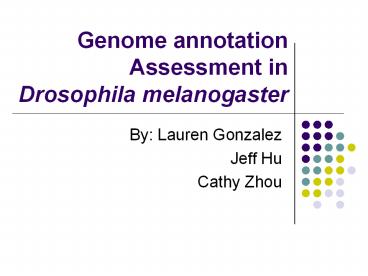Genome annotation Assessment in Drosophila melanogaster - PowerPoint PPT Presentation
Title:
Genome annotation Assessment in Drosophila melanogaster
Description:
Genome annotation Assessment in Drosophila melanogaster By: Lauren Gonzalez Jeff Hu Cathy Zhou Purpose The goal of this genome annotation assessment project (GASP ... – PowerPoint PPT presentation
Number of Views:191
Avg rating:3.0/5.0
Title: Genome annotation Assessment in Drosophila melanogaster
1
Genome annotation Assessment in Drosophila
melanogaster
- By Lauren Gonzalez
- Jeff Hu
- Cathy Zhou
2
Purpose
- The goal of this genome annotation assessment
project (GASP) was to refine the accuracy of gene
annotation technologies so that we could use it
to our benefit to facilitate genome sequencing
and annotation.
3
Identifying STDs
- The researchers created three standard sets of
DNA by which the experimental results were
compared to. - std1
- std2
- std3
4
Standard Sets
- std1 Accurate position of base pairs, but might
not include every gene - std2 Original 80 cDNA sequences
- Std3 Has most genes, but exact placements might
not be known
5
6 classes of gene annotation
- 1. Gene finding
- 2. Promoter prediction
- 3. Repeat finders
- 4. Protein homology annotation
- 5. EST/cDNA alignment
- 6. Gene function
6
A comparison of testing results
7
Understanding results
- True positive
- True negative
- False positive
- False negative
8
Sensitivity vs. Specificity
- Sensitivity ratio of true positives to all real
positives (ratio of true hits) - TP / (TP FN)
- Specificity ratio of true positives to all found
positives (ratio of real hits) - TP / (TP FP)
9
Algorithmic Problem Testing
- We will investigate the ability of a java code to
identify repeat sequences in different ORFs in a
strand of DNA. Our threshold for a repeat
sequence will be different for each repeat
sequence length - Length Threshold
- 1 base pair 4 in a row
- 2 base pairs 8 in a row
- 3 base pairs 12 in a row
- 4 base pairs 16 in a row
10
APT cont.
- We will then take the number of repeat sequences
(and their respective lengths) that are on or
above threshold, and analyze which repeat
sequence has the highest occurrence. We will run
this java program on many different strands of
DNA, and look at which strands have higher repeat
rates, and how reading in different ORFs change
our results.

